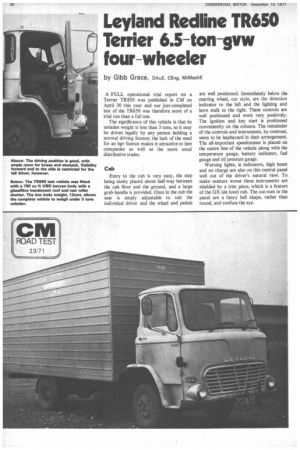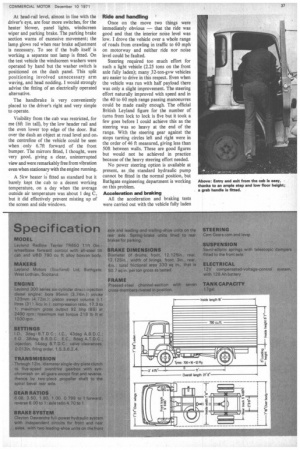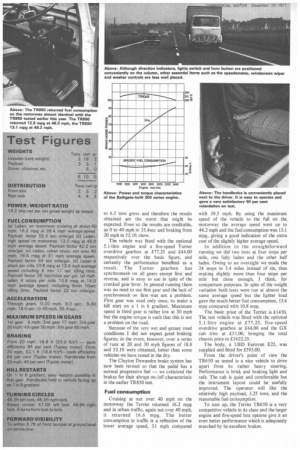Leyland Redline TR650 Terrier 6.5-ton-ginv four-wheeler
Page 38

Page 39

Page 40

If you've noticed an error in this article please click here to report it so we can fix it.
by Gibb Grace, DAuE, CEng, MIMechE
A FULL operational trial report on a Terrier TR850 was published in CM on April 30 this year and our just-completed test of the TR650 was therefore more of a trial run than a full test.
The significance of this vehicle is that its unladen weight is less than 3 tons, so it may be driven legally by any person holding a normal driving licence; the lack of the need for an hgv licence makes it attractive to hire companies as well as the more usual distributive trades.
Cab Entry to the cab is very easy, the step being nicely placed about hallway between the cab floor and the ground, and a large grab-handle is provided. Once in the cab the seat is amply adjustable to suit the individual driver and the wheel and pedals are well positioned. Immediately below the steering wheel, car style, are the direction indicator to the left and the lighting and horn stalk to the right. These controls are well positioned and work very positively. The ignition and key start is positioned conveniently on the column. The remainder of the controls and instruments, by contrast, seem to be haphazard in their arrangement. The all-important speedometer is placed on the centre line of the vehicle along with the temperature gauge, battery indicator, fuel gauge and oil pressure gauge.
Warning lights, ie indicators, high beam and no charge are also on this central panel well out of the driver's natural view. To make matters worse these instruments are shielded by a trim piece, which is a feature of the OX (de luxe) cab. The cut-outs in the panel are a fancy bell shape, rather than round, and confuse the eye. At head-rail level, almost in line with the driver's eye, are four more switches, for the heater blower, panel lights, windscreen wiper and parking brake. The parking brake section warns of excessive movement; the lamp.glows red when rear brake adjustment is necessary. To see if the bulb itself is working a separate test lamp is fitted. On the test vehicle the windscreen washers were operated by hand but the washer switch is positioned on the dash panel. This split positioning involved unnecessary arm waving, and head nodding. I would strongly advise the fitting of an electrically operated alternative.
The handbrake is very conveniently placed to the driver's right and very simple to operate.
Visibility from the cab was restricted, for me (6ft lin tall), by the low header rail and the even lower top edge of the door. But over the dash an object at road level and on. the centreline of the vehicle could be seen when only 6.7ft forward of the front bumper. The mirrors fitted, I thought, were very good, giving a clear, uninterrupted view and were remarkably free from vibration even when stationary with the engine running.
A 5kw heater is fitted as standard but it barely kept the cab to a decent working temperature, on a day when the average outside air temperature was about I deg C, but it did effectively prevent misting up of the screen and side windows_
Ride and handling
Once on the move two things were immediately obvious — that the ride was good and that the interior noise level was low. I drove the vehicle over a whole range of roads from crawling in traffic to 60 mph on motorway and neither ride nor noise level could be faulted.
Steering required too much effort for such a light vehicle (2.25 tons on the front axle fully laden); many ,32-ton-gvw vehicles arc easier to drive in this respect. Even when the vehicle was run with half payload there was only a slight improvement. The steering effort naturally improved with speed and in the 40 to 60 mph range passing manoeuvres could be made easily enough. The official British Leyland figure for the number of turns from lock to lock is five but it took a few goes before I could achieve this as the steering was so heavy at the end of the range. With the steering gear against the stops turning circles left and right were in the order of 46 ft measured, giving less than 50ft between walls. These are good figures but would not be achieved in practice because of the heavy steering effort needed.
No power steering option is available at present, as the standard hydraulic pump cannot be fitted in the normal position, but Bathgate engineering department is working on this problem.
Acceleration and braking
All the acceleration and braking tests were carried out with the vehicle fully laden
to 6.5 tons gross and therefore the results obtained are the worst that might be expected. Even so the results are creditable, as 0 to 40 mph in 35.4sec and braking from 30 mph in 52.1ft show.
The vehicle was fitted with the optional 5.1-litre engine and a five-speed Turner overdrive gearbox at £77.25 and £44.00 respectively over the basic figure, and certainly the performance benefited as a result. The Turner gearbox has synchromesh on all gears except first and reverse, and is easy to use in spite of the cranked gear lever. In general running there was no need to use first gear and the lack of synchromesh on first was not a problem. First gear was used only once, to make a hill start on a 1 in 6 gradient. Maximum speed in third gear is rather low at 30 mph but 'the engine torque is such that this is not a problem on the road.
Because of the very wet and greasy road conditions I did not expect good braking figures; in the event, however, over a series of runs at 20 and 30 mph figures of 18.8 and 52.1ft were obtained, better than some vehicles we have, tested in the dry.
The Clayton Dewandre brake system has now been revised so that the pedal has a normal progressive feel we criticized the brakes for their abrupt on /off characteristic in the earlier TR850 test.
Fuel consumption
Cruising at not over 40 mph on the motorway the Terrier returned 16.2 mpg and in urban traffic, again not over 40 mph, it returned 16.6 mpg. The better consumption in traffic is a reflection of the lower average speed, 31 mph compared with 39.3 mph, By using the maximum speed of the vehicle to the full on the motorway the average speed went up to 46.2 mph and the fuel consumption was 13.1 mpg, giving a good indication of the extra cost of the slightly higher average speed.
In addition to the straightforward running we did two tests at four stops per mile, one fully laden and the other half laden. Owing to an oversight we made the 24 'stops in 5.4 miles instead of six, thus making slightly more than four stops per mile but close enough. I think, for comparison purposes. In spite of the weight variation both tests were run at almost the same average speed but the lighter load gave the much better fuel consumption, 13.6 mpg compared with 10.8 mpg.
The basic price of the Terrier is £1470. The test vehicle was fitted with the optional 5.1-litre engine at £77.25, five-speed overdrive gearbox at £44.00 and the GX cab trim at 431.00,. bringing the total chassis price to £1622.25.
The body, a MID Eurovan E23, was supplied and fitted for £593.00.
From the driver's point of view the TR650 as tested is a nice vehicle to drive apart from its rather heavy steering. Performance is brisk and braking light and safe. The cab is quiet and comfortable but the instrument layout could be usefully improved. The operator will like the relatively high payload, 3.25 tons, and the reasonable fuel consumption.
To sum up, the Terrier TR650 is a very competitive vehicle in its class and the larger engine and five-speed box options give it an even better performance which is adequately matched by its excellent brakes.




































































































